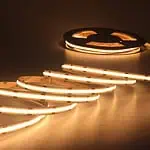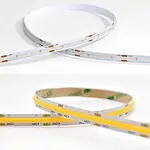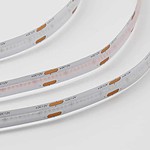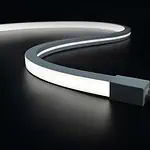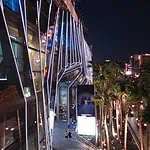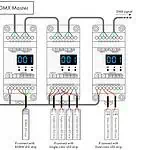Are you facing glaring issues, or are your LED strips too bright? Using an LED diffuser can save you from these issues!
LED diffusers are lids or covers for LED strip lights that diffuse the lighting and bring an even and uniform illumination. They can be of different types- transparent, frosted, milky white, opal, colorful, etc. To reduce the hot spot effect, frosted LED diffusers work best. But if you want something in between or not too transparent, not too frosted, go for the opal diffusers. Besides, you will also find an option to choose the diffuser’s shape as per your requirements.
In this article, I will mention every detail you need to know for choosing an LED diffuser for LED light strips. No more talking; let’s dive in together–
What Is An LED Diffuser?
The LED diffuser comes together with the LED profile, like a cover for the LED strip lights. It ensures that light spreads evenly on the surface, eliminating glaring issues. These diffusers are made from materials like polycarbonate or acrylic and come in different sizes and shapes for other uses. The major benefit of using an LED diffuser is that it provides even lighting and keeps your fixture safe from any external damage.
Benefits Of Using LED Diffuser
LED diffusers ensure that light is spread out perfectly and that there are no bright spots from the LED chips. Here are the reasons for which you should use an LED diffuser-
- Creates uniform light spread
- Reduces glaring and reflection issues
- Helps eliminate diode hot spots
- Protects the light fixture from dust and dirt
- Aesthetically pleasing
- Easier to clean
Do LED Strip Lights Require Any Diffuser?
The direct answer would be no; the LED light strip does not need any diffuser. But using them can be beneficial. Residential applications usually require LED diffusers as their perfect finished light fixture is necessary. Often, light strips have visible diodes that may not look very nice. In this situation, you can use an LED diffuser and an aluminum channel to improve their appearance. This combination gives you a better-looking final product. However, if you prefer not to use an LED diffuser, you can choose LED light strips with a water-resistant silicone coating. Though these silicon coatings are not as effective as a diffuser, these strips can still protect the lights and spread brightness evenly.
Besides, Chip-on-board or COB LED light strips don’t usually require a diffuser. They have many tiny LED lights packed closely together in a small space. These lights are covered with a special coating called phosphorus. This coating makes the light spread out evenly, and there are no extra-bright spots like you might see in older-style light strips. Therefore, instead of having separate chips with spaces in between, the whole strip of lights can have an even spread of light. If you use COB light strips or fixtures, you do not need a cover to diffuse the light. But the diffuser can still be helpful for additional protection.
Types Of LED Diffusers For LED Strips
You can find many types of LED diffusers in the market. As a result, this can confuse you about which one to buy if you don’t have any idea about them. So, let’s see some of the common types of LED diffusers here to help you know more about the types-
Based On Lighting Output
Considering the lighting effect after adding diffusers, they can be of three types; these are as follows-
a. Transparent LED Strip Diffuser
A Transparent LED Diffuser made of clear material is used to protect LED strip lights. It allows the light to pass through without hindrance. Also, this diffuser maintains the brightness and clarity of the strip lights. It is ideal for applications where you want to preserve the unobstructed visibility of the LED strip lights. Therefore, LED strips can provide some protection against dust or physical damage.
b. Frosted LED Strip Diffuser
For spreading brightness evenly, a frosted LED diffuser is an excellent option. It is made from acrylic or polycarbonate and comes with a frosted finish. For this reason, customers often choose this diffuse. Also, it can remove hot spots in the light settings and protect the strips from any external ingress. Generally, frosted LEDs have a length of 78.74 inches; you can cut any length based on your needs.
c. Opal LED Strip Diffuser
Opal LED diffusers are neither so frosted nor so transparent but something in between. These are made by adding pigmentation to clear base polymer to hide the light source. They work best for minimizing hot spots and glaring issues. Also, it can spread the lights evenly and protect the strips from dust, moisture, and environmental elements.
Based On Shape
Based on the shape, LED strip diffusers can be of the following types-
a. Flat LED Strip Diffuser
These are the most common diffusers used for LED strips. The flat and thin shape of these diffusers makes them ideal to use at any time or location. You can use these diffusers on the LED strip under the cabinets, bathrooms, staircases, or other narrow spaces. Besides, they are excellent for built-in or recessed LED strip installation.
b. Round LED Strip Diffusers
Round LED strip diffusers are usually used for decorative or accent lighting. You can also use them for DIY projects where you need to give your lighting a spherical structure rather than the traditional flat shape. Besides, you can use these diffusers to make DIY signage, too.
c. V-Shape LED Strip Diffusers
V-shaped diffusers are designed for corners where flat or round ones can’t fit. You can use these differently on the edges of the ceiling or floor. But before placing them on the edges of the surface, you need to learn the techniques of installing LED strips in the corner. This guide will help you in this case: How do you install LED strip lights around corners?
Materials Used In LED Diffuser
LED diffusers can be of several types, such as plastic, Glass, PMMA, silicon, etc. Here, I have described them deeply; check them out–
Plastic
Often, plastic is used to make diffusers, which are easy to replace. Also, it can discolor over time because of exposure to heat from the strips and is less durable. However, plastic diffusers are very common now, and you can see many diffusers made with high-quality plastic in the market.
Glass
Glass diffusers manage the softness and even brightness of LED strips. Glass is good at giving off cozy light and can also accurately show different colors because it absorbs light wavelengths. Also, it is good at spreading heat because it doesn’t trap heat like plastic or silicone. However, it’s essential to know that Glass is heavier than plastic and silicone, so it is not the best choice if the diffuser needs to hang somewhere. Furthermore, this type of diffuser is more expensive than other variants.
PC
The primary material of LED light diffusers is polycarbonate. It is lightweight and durable and will not bend or twist under pressure. Also, you can mold it for multiple shapes, which is excellent for diffusing hot spots of LED. This unbreakable material can prevent high temperatures. So, for this reason, the LED light diffuser will not warp or melt at higher temperatures while operating like other types of plastic materials. Besides, this material is viral among consumers, as it can easily be shaped to set any space. However, it is best to avoid using this material where direct sunlight stays for a long time; otherwise, the PC will discolor.
PMMA
Although PMMA or acrylic is a kind of plastic that looks like glass, it contains some different features. For instance, PMMA has fire prevention functions and does not melt and burn at very high temperatures. So, this is safe, and you can choose to use this material rather than glass. Apart from this, other advantages of PMMA are its lightweight and easy installation. Also, its transmission system is excellent, which you can compare with glass materials. Plus, you can choose PMMA over PC as it provides the best light transmission.
Silicone
Another famous material used in LED diffusers is silicone. It is the perfect pick for strip lights because silicone does not change the appearance of light color. You can effortlessly install it with adhesive or double-sided tape. Also, it does not trap heat like plastic and glass do. Besides, this is lighter and cheaper than glass diffusers. However, it can sometimes provide harsh shadows and be less durable than glass diffusers.
How Do You Choose The Best LED Diffuser For Light Strips?
When selecting the proper diffuser for the strips, you need to consider some factors to get the one you want. Follow the section below–
Consider Where To Install
When picking a diffuser for your LED lights, consider where you’ll use them first. If you install LED strips outdoors, use a rigid diffuser that won’t break easily. But if you’re using them for indoor lighting, choose a diffuser that looks good and fits the style of your space. That is, you need to select a robust diffuser for outdoor installation and for indoor preference visual appeal when selecting diffusers.
Length & Width
LED strip diffusers can be of different lengths. Most of them are 72 inches long, but if you want, you can get them in 96 inches or even shorter sizes. These diffusers work well with aluminum channels and cover plates. Moreover, they have standard lengths, so you don’t have to make your fixture. For more information, you can check What LED Strip Widths Are Available?
Shape Of The Diffuser
Diffusers come in multiple shapes, such as flat, tented, and curved diffusers. Flat diffusers are the most common variants ideal for any application, residential or commercial. You can use them for built-in LED strip installation on the ceiling, floor, or other surfaces. On the other hand, a tented diffuser sits on the channels, and it adds extra height. For spotless outcomes, you can choose curved diffusers.
Consider The Color
Color temperature is also significant to consider when selecting a diffuser. They are available in different colors. For instance, a multi-color diffuser can add a pop of color or warmth to your space. Meanwhile, you can use the white diffuser for a natural and neutral look. Also, by experimenting it with different places in various spots, you can see how it changes the colors in the room.
High-Quality Materials
High-quality material is always necessary for any diffuser as it can give you an effective result in the many years to come. If you go for cheaper options, they might change color and get fragile as time passes. This messes up the light’s appearance. So, choose an LED diffuser that is long-lasting and made with the best materials while purchasing.
Lighting Effect
The lighting effect can be different depending on the types of diffusers. In general, many consumers prefer frosted diffusers because their light uniformity and transmission are better. Besides, you can go with a glass diffuser to create cloudy atmospheres. However, if you go with transparency, you will get proper illumination and save the strips from debris and dust.
How To Diffuse LED Strip Lights?
You can diffuse LED strips with LED diffusers, but there are other ways that are also available. Check them out–
Method#1: Use LED Strip Diffusers
The most effective way to diffuse your LED strip lighting is using LED diffusers. These cover the LED strip and hide the pointing illuminated LEDs. Thus, you can get even and diffused lighting without any visible hot spots. However, you need a channel where you need to put the LED strip and then add the diffuser. In this case, I suggest you choose a deep channel rather than a shallow one. This will give a more diffused illumination. Besides, when choosing the diffuser’s shape, go for a curved one. A curved diffuser lowers the brightness and spreads the lights more evenly than a flat one. It also covers a more extensive area and shines light over a broader range.
Method#2: Using High-Density LED Strips
Using a high-density LED strip can solve the issue of hot stops. The higher the density, the more minor the LED spot. However, high-density LED strips are a bit more expensive than low-density ones. Yet, if you want a more diffused light, go for the high-density ones.
Method#3: DIY LED Diffuser Ideas
Besides using high-density LED strips or LED diffusers, there are DIY options to diffuse your LED strips. You can use baking paper or acrylic to create a DIY LED diffuser for this purpose. Here is the process how to use them-
a. Baking Paper
Baking paper, also known as parchment paper, can reduce the appearance of a plastic lens cover cap. However, this paper looks more milky or cloudy than most diffusers, and reduces much of the light that comes through. But it generally gives a soft, diffused appearance and has a surface that can handle heat well.
b. Thin Plexiglass Or Acrylic
You can use a clear plastic sheet such as plexiglass or acrylic to make a rigid cover for LED lights. To begin, just rough it up with sandpaper and cut it to the correct size. This easy method works well for more extensive projects or when you need a particular kind of light diffusion. Sometimes, you can buy acrylic sheets that are already frosted, giving them the diffused appearance you want.
How Do You Install An LED Diffuser In An LED strip?
To install an LED diffuser in strips, you can follow this step-by-step guide. This way, you can make a hassle-free installation without any professionals.
Step-1: Gather Necessary Materials
- Scissors
- Double-sided tape
- Measuring tape
- Cleaning supplies (optional)
- Mounting hardware
Step 2: Cut The Aluminum Extrusion Channel To The Required Size
Aluminum extrusions are soft so that you can easily cut them with a miter or hand saw. To get a neat cut, wrap some blue plastic stretch or painter’s tape around the part you want to cut. However, if you’re using a saw, make sure to use a blade designed for soft metals like aluminum, as blades for non-ferrous metals work better in this case. Read this article for more details- Ultimate Guide To Aluminum Profile For LED Strip.
Step 3: Insert The LED Strip and cover It Up With A Diffuser
Try using a frosted diffuser; they can make the lights look softer and less harsh. Even though there can still be some hot spots, there won’t be much. If you want to reduce the hot spots and need a smooth, even light, go for a milk diffuser. Most people like this because it gives a consistent light that looks good. Also, you can use a clear diffuser to protect your LEDs and make your light fixture look complete without losing brightness.
Step 4: Mounting The Channel
There are a few common ways to attach an aluminum extrusion channel. Depending on what you’re using it for, you can choose to use:
- U-Clips
- Screws
- Magnets
- Recessed
Remember, not all channels or extrusions are alike. Follow the manufacturer’s suggested method to attach your light strip channel securely.
Some Tips To Use LED Diffusers For Light Strips
- You need to match the LED diffuser with the exact size of your LED strip or larger. This way, you can cover the strips perfectly and reduce the chances of making the strip back of the LED diffuser visible.
- Try not to install LED diffusers close to the radiators or fireplaces. Because this can deform the plastic as time goes on.
- When setting the LED strip lights, place the diffusers evenly to prevent certain areas of your LED lights from getting hot. As a result, the light will spread equally across the entire strip.
- If you pick LED diffusers that go with the color and tone of your strips, you can make a space look pleasant and well-lit, suitable for any kind of place.
FAQs
Yes, you can replace or remove the LED diffuser. First, you need to ensure the power is off, gently detach the diffuser, and swap it with a new one if needed. However, you need to always follow safety guidelines during any adjustments.
The best material for a diffuser would be acrylic, as it is usually better than polycarbonate when it comes to reducing the brightness. It’s good at spreading light from LEDs and is easy to shape. And, people like to use acrylic rather than any other material in various options, especially in commercial light fixtures.
Different sizes of diffusers for LED light strips are available in the market. Therefore, you can find them in 8mm, 10mm, 12mm, 20mm, and even wider options. The bigger ones can hold two LED strips side by side and make the light brighter. However, a common size is 2 meters. You can easily cut them to the length you want. If you want a longer diffuser, you can connect two pieces of aluminum channels by putting them next to each other.
It is better to use a diffuser for LED strip lights as you can distribute the brightness evenly, reducing glare. A diffuser can minimize harsh lights from your area and protect the strip from dust. So, if you have an LED strip, you can create a comfortable and visually appealing atmosphere with diffusers.
It all comes down to how wide the light spreads and how far apart the lights are. If you have surface mount LEDs with a 110° Field of View, the rule is roughly 1:1. If the LEDs are 1 inch apart, you should have a little more than 1 inch of space from the LEDs to the widest angles of the diffuser.
Conclusion
LED diffusers are the right way to finish your strip light installation. They can minimize all the hot spots and extra brightness from the strips. From clear to cloudy, you can choose a diffuser made with different materials. For example, you can go with transparent diffusers made of glass and fostered diffusers made from polycarbonate and acrylic. Also, their installation process is easy, so it will allow you to do some experiments with different styles and combinations.
However, whatever diffuser you choose, having a quality LED strip is crucial to ensure the best lighting output. And for this, the LEDYi LED strip is your ultimate solution. We manufacture different types of LED strips and supply more than 30 countries. Besides, our fixtures come with a 3 to 5 year warranty. So, place your order now!
